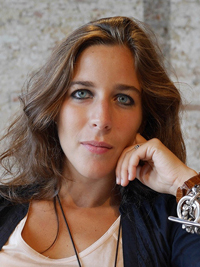Marta Calzolari

XXV Cycle - (A.A. 2009-2010)
Architecture Technology
Home Institution: University of Ferrara
Scholarship
Curriculum: Architecture (ICAR12)
Research Topic: Energy efficiency of historic buildings
Tutor DA-UNIFE: Pietromaria Davoli
Nationality: Italian
Email: marta.calzolari@unife.it
Profile
Biography
Master of Architecture “with honour” (2008) and Ph.D. in Building Construction (2013), University of Ferrara (3 scientific research award). Since 2009 she is member of the research centre Architettura>Energia at the Department of Architecture with which she collaborates on researches for the energy retrofit of existing buildings, in particular of historical ones.
Since 2015 she is a research fellow as operations coordinator of the project for the energy screening of the University building stock. Since November 2015 to Februray 2017 she was member of GBC Italia for the Horizon 2020 Project “Build Upon”. Since Februry 2018 she is member (as part of the Host Istitution) of the project “HeLLo” H2020 - MSCA-IF-2017-EF to create a Lab to test the performance of insulation material for the energy retrofit of historic buildings.
Since 2012 she teaches as Adjunct Professor of Environmental Design and Building Construction at the Department of Architecture - University of Ferrara.
Research skills
Building Construction | Energy Retrofit | Historic Buildings | Sustainable Architecture | Wood Architecture
Scientific activities
ORCID ID:
0000-0002-9749-7214
IRIS UNIFE ID:
rp10198
Doctoral research
Evaluation of the energetic behavior of historical architecture. Analysis of the calculation method of the energy state of the art and corrective proposals
A project of energy retrofit of an historic building starts from the preliminary assessment of its energy potential and residual performance, in order to tailor interventions and properly address the energy needs, without losing or jeopardizing its historic value. This approach is relatively new and specific industry regulations have not yet been developed. The absence of specific legislation means that a dedicated methodology for calculating the energy performance of historic buildings is not included in the best practices of intervention. Currently the energy performance of historic buildings is calculated with the same tools developed for modern buildings. The research started from the hypothesis that the types of calculation available today present some limits of applicability, in particular if used for the evaluation of historical architecture, which has technical, geometric, and architectural characteristics that differ significantly from the ones of newer buildings. The use of non-specific instruments can lead to errors in the calculation of the residual energetic performance of buildings. This calculation error can consequently lead to choices of intervention that can be harmful to the conservation of the building, to final level of comfort of its interior, or to its resulting energy efficiency. The study, therefore, critically analyzes the current methods of calculating energy efficiency, with the aim of verifying their validity and limits of applicability by testing them on a sample of historic buildings. These objectives called for the refinement of the simplified method, more suitable to historic buildings, and the development of a new instrumental method, which can be used in parallel with the analytical calculation.
Keywords
Energy Retrofit | Historic Architecture | Calculation Method | Energy Simulation | Experimental Test

